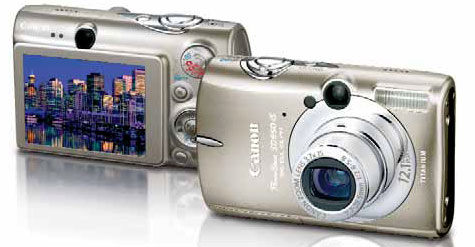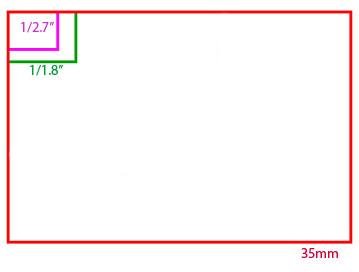The Digital Sensor: A Guide to Understanding Digital Cameras
by Wesley Fink on April 21, 2008 1:00 AM EST- Posted in
- Digital Camera
A few years ago, all digital cameras were "point and shoot" and they were very expensive compared to film cameras. Digital prices dropped rather quickly as digital sensor resolution continued to increase. Soon enough digital "point-and-shoot" cameras were available at every price point from a basic snapshot to the more serious models geared at the prosumer market.
At the dawn of the consumer digital SLR in 1999, a 2.7MP (megapixel) DSLR with an APS C sensor was considered an incredible buy at $5000. Tremendous growth in market share and the falling prices of DSLR cameras in the years since have created new buying options for those shopping for an upgrade to an existing camera or even a first camera. This has been particularly true in the last couple of years. All of the old reasons to own a point and shoot instead - with lower cost leading the way - have fallen by the wayside as the DSLR has continued to evolve and become both very price competitive with P&S and much easier to use.
However, many new DSLR buyers are walking into a brave new world with blinders on. The first question everyone should ask is why should you buy a DSLR instead of a point and shoot? Are there real technical advantages to DSLRs? After all the ads for point-and-shoots are hyping the same range of sensor resolutions that you will find in digital SLR cameras, so why buy a DSLR? The answer to that question is what really prompted this article.

Yes, you can buy 10MP and 12MP point-and-shoot cameras - the same megapixel range as current mainstream DLSR cameras - but they cannot possibly produce the same image quality over the same wide range of shooting conditions as a digital SLR. The reason why is simple physics, as the point-and-shoot sensors are much smaller than sensors in a DSLR. In fact, that is also the very reason why point-and-shoot digital cameras were the only choices in the market for a few years.
The early sensors were much lower megapixel resolutions, far too low to begin to compete with film photography. Photo hobbyists saw few advantages in moving to a low resolution system since the reason they used an SLR was high image quality. It wasn't until resolutions reached the 2-4MP range that there was any interest in a digital SLR.

The early sensors were also very small, developed primarily for video usage. The 1/2.7" compact sensor is 5.3x4.0mm and the larger 1/1.8" is 7.2x5.3mm - compared to 35mm at 24x36mm. These typical compact sensors are just a tiny fraction the size of 35mm sensors, and these sensors were among the largest available in P&S digital cameras. Some tried to develop proprietary systems based on a smaller sensor size with more compact lenses, but nothing caught on in the industry. The cost of early sensors was also astronomical, making the early digital SLR cameras only useful for production, high volume photography where the cost could be justified.
Finally, early digital development saw sensor resolution and size in constant evolution. With sensor size changing with each new generation, it was much easier to design a point-and-shoot camera around each new sensor generation using a dedicated and non-interchangeable lens. Until sensor size stabilized, a digital SLR that used either existing 35mm lens systems or a new "standard size" was not practical.










72 Comments
View All Comments
Johnmcl7 - Monday, April 21, 2008 - link
I do agree with you there that it is desirable to have deeper depth of field (particularly on macro) but I think the difference is that on an SLR you have the choice - you can shoot wide open and have shallow depth of field or you can stop down (and normally have to use up the ISO advantage) to get depth of field. On a camera with a small sensor you are generally stuck with the deep depth of field whether you want it or not.John
finbarqs - Monday, April 21, 2008 - link
I hope nobody is using F/1.2 when shooting a portrait. Unless you want only a nose to be in focus. With something THAT shallow, you either have to REALLY step back and use distance to your advantage to get what you want in Focus. Professional Wedding photographers will not TOUCH anything above f/5.6 as you don't want to get ONLY the bride in focus while the groom is OOF.People, remember there are multiple factors that affect DOF. Aperture is definitely one of them, distance, and Focal Length.
Obviously you want something very shallow with great bokeh, then you would get close to your subject, open up your aperture, and have a telephoto focal length.
The thing is, on a FF sensor, you "see more" on the same focal length as a cropped sensor. Well put wesley, a 50mm is a 50mm. For those of us with cropped sensors, slap a 50mm on your camera. (or zoom to 50mm). Look at your subject with your naked eye, then look through the view finder. SAME SIZE AND SHAPE! Nothing gets larger! Supposedly a telephoto range (greater than normal) should have some zoom effets shouldn't it? I mean APS-C sensors are either 1.5 or 1.6 smaller than a full frame, that means the normal focal length should be around 27mm? So 50mm should be 75mm for nikons and 80mm for canons! That means you should see some zoom in 50mm! but nope! you don't! in fact, the only time you'll see the zoom is AFTER you fire the shutter and it displays the image to fill that 2.5" or 3.0" inch lcd you have! (or even 2.0") So where does the FF excel? you place 2 cameras exactly side by side of each other, same focal length, same focus point. Same lens. Through the Viewfinder, you'll see the nice Bokeh of your subject on BOTH cameras, exactly the same. Difference? the FF has more frame coverage! Thus, having better "DOF" (or lack thereof) because of the more frame coverage! On this note, let's all by Hasselblad's Medium FF and get some nice digital backs! ;)
haplo602 - Tuesday, April 22, 2008 - link
Hmm ... In my understanding the difference in FF to APS-C is CROP.A 50mm lens on APS-C has the same DOF, same perspective characteristic as on a FF camera, but the sensor is smaller, so you basicaly get a CROP of the original FF image. There is only a perceived zoom effect as the image is a smaller area.
For Nikon you get 1.5x smaller image area, but everything else is the same as on FF.
melgross - Tuesday, April 22, 2008 - link
It has to do with distance from the subject as well. Perspective is the ratio of the distance to the subject to the distance to the background.So, to get the same size on sensor, with the same lens length, you must either move closer, or further, changing the perspective, and the depth of field.
finbarqs - Monday, April 21, 2008 - link
Medium Format* sorry, typo :)Johnmcl7 - Monday, April 21, 2008 - link
Other way round - a larger sensor gives you *less* depth of field which as you quite rightly point out is a strong advantage of a larger sensor.John
pinto4402 - Monday, April 21, 2008 - link
DOF is also a function of the lens. Some ultra-serious photographers are willing to pay $2500 for a Canon 85mm 1.2L over a 85mm 1.8 (which is just as sharp and which only retails for $300), because the 1.2L has a softer, more pleasing DOF effect.TETRONG - Monday, April 21, 2008 - link
Cool article.Looking to buy a camera pretty soon here.
What do you folks think about the G9?
Is there a particular brand I should favor?
Also, are there any cameras available that do "tricky" stuff, like Infrared, Macro, or that neat effect when cities look miniature? (Can't find an example)
I read an article about a guy a few years back that would setup a scene, then he would walk around selectively lighting certain aspects in trippy ways to make a final composite image.
Anyone know what this is called, or where I can learn more about it?
Much obliged!
strikeback03 - Tuesday, April 22, 2008 - link
Is "fisheye" what you are looking for for the miniature cities?and the selective lighting is often called "Painting with light"
plenty of compact cameras can do OK macro if you can get really close to your subject, but as this is often hard for reasons of lighting and/or scaring off the subject, an SLR with a real macro lens is still beneficial.
pinto4402 - Monday, April 21, 2008 - link
There was an article at http://www.popphoto.com/popularphotographyfeatures...">http://www.popphoto.com/popularphotogra.../4923/th...about infrared photography. It also discusses a company that is modifying certain digital cameras for infrared use.